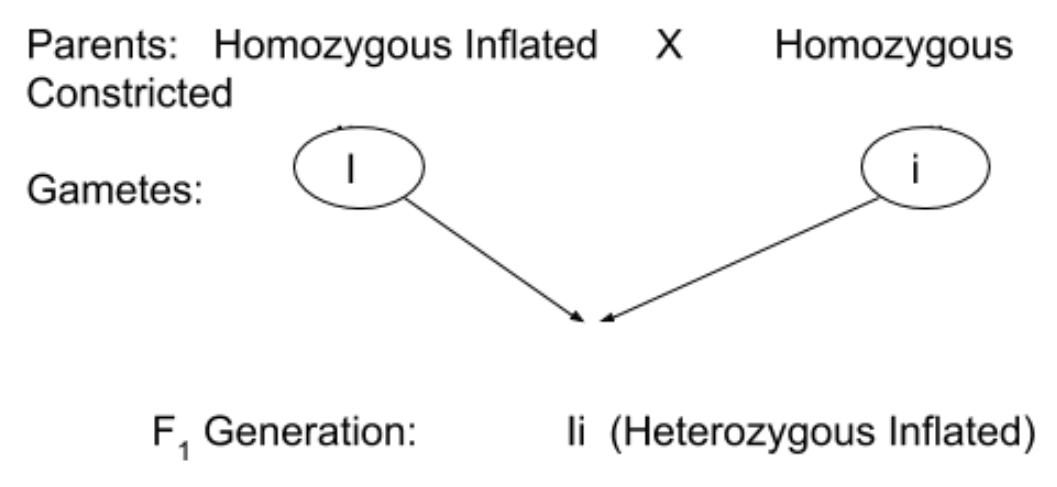
A homozygous inflated pod shaped variety of pea plant (I) is crossed with a constricted variety of pea plant (i). Answer the question that follows:
State the Mendel’s law of dominance.
Answer
510k+ views
Hint: The F1 generation produced by cross fertilization shows the phenotype of the dominant parent.
Complete Answer:
Mendel is known to us for enlightening about the way inheritance of traits occurs. He is rightfully called the Father of Genetics. He did extensive mathematical and hybridization experiments on garden pea plant and formulated the law of genetics as follows:
A) Law of Dominance
B) Law of Segregation
C) Law of Independent Assortment
Let us try to theoretically replicate what Mendel did in order to understand and state the law of dominance. We are provided with parental genotypes and phenotypes. We will make a monohybrid cross based on that.

Here, we observe that all the offspring of F1 generation are with inflated pods. It suggests that the inflated pods phenotype is a dominant trait. It is controlled by the dominant allele of the gene (I/i) which is responsible for controlling the pod shape. The constructed shape is a recessive trait. Although the F1 offspring have two different alleles of the same genes (hence, they are heterozygous), yet only one of the alleles is capable of asserting its effect, making the progeny with inflated pods.
Such an allele which expresses itself in the heterozygous condition is called the dominant allele while the one whose effect is masked is called the recessive allele. The dominant allele, by convention, is denoted by the capital letter (I in this case) and the recessive allele is denoted by small letters (i). Mendel used the term ‘factors’ for alleles.
Hence, we can write the law of dominance as follows:
When an organism has two factors (or alleles) of a gene, controlling one character with contrasting traits, then in such an organism, the phenotype will be governed by the dominant allele. The allele being phenotypically expressed in heterozygous condition is called the dominant allele while the one being silenced in the presence of a dominant allele is called the recessive allele.
Note: Mendel made two types of crosses, namely, monohybrid cross studying the inheritance of one gene and one character, and dihybrid cross studying the inheritance of two genes or two characters.
The law of dominance and law of segregation are based on his observation in monohybrid cross, however, they are true for dihybrid cross as well. The law of independent assortment is derived from the dihybrid cross.
Complete Answer:
Mendel is known to us for enlightening about the way inheritance of traits occurs. He is rightfully called the Father of Genetics. He did extensive mathematical and hybridization experiments on garden pea plant and formulated the law of genetics as follows:
A) Law of Dominance
B) Law of Segregation
C) Law of Independent Assortment
Let us try to theoretically replicate what Mendel did in order to understand and state the law of dominance. We are provided with parental genotypes and phenotypes. We will make a monohybrid cross based on that.

Here, we observe that all the offspring of F1 generation are with inflated pods. It suggests that the inflated pods phenotype is a dominant trait. It is controlled by the dominant allele of the gene (I/i) which is responsible for controlling the pod shape. The constructed shape is a recessive trait. Although the F1 offspring have two different alleles of the same genes (hence, they are heterozygous), yet only one of the alleles is capable of asserting its effect, making the progeny with inflated pods.
Such an allele which expresses itself in the heterozygous condition is called the dominant allele while the one whose effect is masked is called the recessive allele. The dominant allele, by convention, is denoted by the capital letter (I in this case) and the recessive allele is denoted by small letters (i). Mendel used the term ‘factors’ for alleles.
Hence, we can write the law of dominance as follows:
When an organism has two factors (or alleles) of a gene, controlling one character with contrasting traits, then in such an organism, the phenotype will be governed by the dominant allele. The allele being phenotypically expressed in heterozygous condition is called the dominant allele while the one being silenced in the presence of a dominant allele is called the recessive allele.
Note: Mendel made two types of crosses, namely, monohybrid cross studying the inheritance of one gene and one character, and dihybrid cross studying the inheritance of two genes or two characters.
The law of dominance and law of segregation are based on his observation in monohybrid cross, however, they are true for dihybrid cross as well. The law of independent assortment is derived from the dihybrid cross.
Recently Updated Pages
Master Class 12 Business Studies: Engaging Questions & Answers for Success

Master Class 12 English: Engaging Questions & Answers for Success

Master Class 12 Social Science: Engaging Questions & Answers for Success

Master Class 12 Chemistry: Engaging Questions & Answers for Success

Class 12 Question and Answer - Your Ultimate Solutions Guide

Master Class 11 Economics: Engaging Questions & Answers for Success

Trending doubts
Draw a labelled sketch of the human eye class 12 physics CBSE

a Tabulate the differences in the characteristics of class 12 chemistry CBSE

Which one of the following is a true fish A Jellyfish class 12 biology CBSE

Why is the cell called the structural and functional class 12 biology CBSE

Differentiate between homogeneous and heterogeneous class 12 chemistry CBSE

Write the difference between solid liquid and gas class 12 chemistry CBSE




